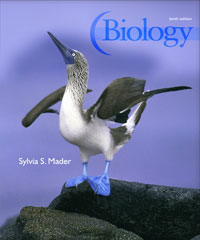Biology (Mader), 10th EditionChapter 41:
Reproductive SystemsLearning OutcomesAfter studying this chapter, you should be able to accomplish the following outcomes.
How Animals Reproduce
- Contrast asexual and sexual reproduction.
- Compare and contrast oviparous, ovoviviparous, and viviparous life history strategies.
- Explain the significance of the shelled egg for a life on land.
Male Reproductive System
- List the parts of the human male reproductive system and their functions.
- Explain the events of male orgasm.
- List the constituents of semen and the source of each.
- Describe the structure of the testis and the process of spermatogenesis.
- Explain how the testes are regulated by hormones.
Female Reproductive System
- List the parts of the human female reproductive system and their functions.
- Explain events of female orgasm.
- Summarize the events of the ovarian and uterine cycles, and explain how these two cycles are regulated.
- Describe the roles of progesterone, estrogen, and human chorionic gonadotropin (HCG) in pregnancy.
- Describe the anatomy and function of the female breast.
Control of Reproduction
- List the various means of birth control available for males and females, comparing the relative efficacy, advantages, and disadvantages of each.
- List and describe the available means of assisted reproductive technology.
Sexually Transmitted Diseases
- Describe the most common sexually transmitted diseases, along with their major symptoms and their causative agents.
Health Focus: Preimplantation Genetic Diagnosis
- Explain how and why preimplantation genetic diagnosis is used.
Health Focus: Preventing Transmission of STDs
- Describe the various approaches that may be used to prevent the transmission of STDs.
 | 




